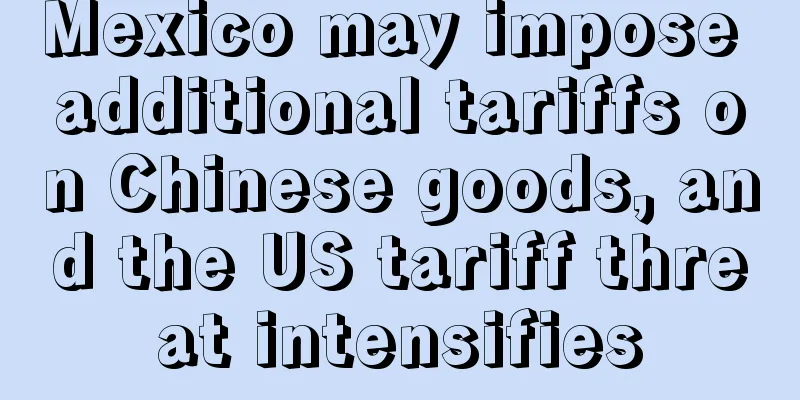Mexico may impose additional tariffs on Chinese goods, and the US tariff threat intensifies

|
It is learned that recently, according to foreign media reports, the Mexican government is currently negotiating with the United States to respond to US President Trump’s threat to impose a 25% tariff on its goods by early March, and is considering imposing tariffs on Chinese goods to alleviate the pressure brought by Trump’s new tariff policy. Mexican President Claudia Sheinbaum said at a news conference on Monday that a meeting between Mexican Economy Minister Marcelo Ebrard and U.S. Commerce Secretary Howard Lutnick was still ongoing and that the Mexican government was actively pushing for a deal with the U.S. government. The Trump administration told Mexican officials during the talks that Mexico should impose tariffs on Chinese goods if it wants to avoid U.S. tariffs. Previously, Trump demanded that Mexico and Canada take more measures to limit immigration and the flow of fentanyl into the United States, otherwise they would face tariff threats. Trump originally planned to start implementing these tariffs on February 1, but it has been postponed for a month. At the same time, after the United States imposed an additional 10% tariff on all imports from China in early February, China also imposed a 10% tariff on American goods. Subsequently, Trump once again threatened to impose a comprehensive tariff of 25% on Canada and Mexico. In addition, this month Trump also ordered a 25% tariff on all imported steel and aluminum, and signed a measure that could impose reciprocal tariffs on U.S. trading partners in April to raise money for the upcoming tax and spending bill. Trump also plans to impose new tariffs on imported cars around April. The impact of these escalating trade policies on the cross-border e-commerce industry is becoming more and more significant. If Mexico finally decides to impose tariffs on Chinese goods, this will directly affect sellers who rely on cross-border e-commerce platforms for trade. This measure may lead to higher costs for cross-border e-commerce, which in turn will push up consumer purchase prices and affect consumer purchasing decisions. In the coming months, tensions in the global supply chain may lead to delayed goods supply, increase logistics costs for cross-border e-commerce, and further increase the operational pressure on e-commerce platforms. As trade disputes between countries intensify, cross-border e-commerce companies need to pay close attention to policy changes and flexibly adjust supply chain strategies to ensure that they remain competitive in this uncertain trade environment. Author✎ Summer/ |
<<: Home Depot's Q4 revenue was $39.7 billion, up 14.1% year-on-year
>>: New research: Too many ads cause 29% of e-commerce shoppers to abandon their shopping carts
Recommend
What is HTS coding? HTS coding review
HTS is the abbreviation of Harmonized Tariff Sched...
It only takes two steps to learn how to embed words accurately
Amazon keyword embedding mechanism 1. Amazon’s so...
ChatGPT has evolved! A big seller has invested nearly 2 million!
It was observed that this morning, a topic #ChatGP...
What is Overseas Consultant Help? Overseas Consultant Help Review
Overseas Consultants is a one -stop service center...
40% of Americans will cut back on Black Friday spending! Is Amazon's Fall Prime Day so influential?
<span data-docs-delta="[[20,"获悉,据外媒报道,亚马逊近...
What is CSA? CSA Evaluation
CSA is the abbreviation of Canadian Standards Asso...
Ultimate Guide: How to Sell Seasonal Products as an Amazon FBA Seller
Sellers, have you ever had such questions: Is it ...
What is Newegg? Newegg Review
Newegg is a professional e-commerce consumer servi...
Even if you have money, you may not be able to ship goods! Suspension of flights, price increases, container shortages, port strikes...
The blockage of the Suez Canal at the end of March...
2021 National Dog Day in the United States: Amazon, Walmart and many other platforms have launched promotions!
It is learned that the 2021 National Dog Day in th...
Is the supply chain saved? U.S. West Coast labor negotiations reach a preliminary agreement!
It is learned that as the retail industry enters t...
What is Libra? Libra Review
Libra is a cross-border e-commerce comprehensive s...
255 agents were arrested by the police, and cross-border e-commerce sellers were defrauded of all their money!
We know that agency operation has always been con...
What is Zoox? Zoox Review
Zoox was founded in 2014 and is committed to build...









